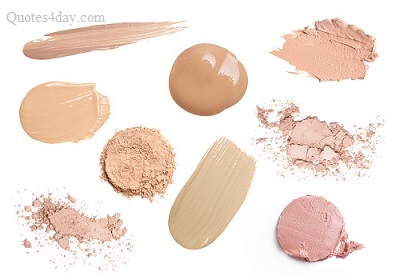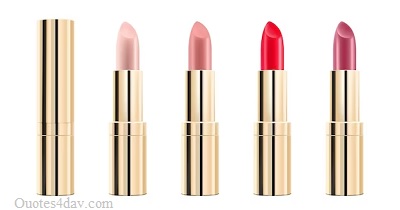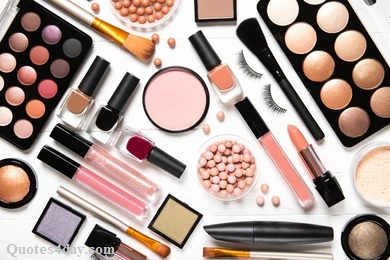When choosing care products, you probably carefully study the components in the composition, their compatibility, and their effectiveness. But when it comes to the choice of decorative cosmetics, the whole focus shifts to shades and textures. And meanwhile, how the products lie down, shaded, and keep during the day, largely depends on the composition.

To figure out what to look for when choosing decorative cosmetics, which ingredients are beneficial and which are best avoided,
What Are Decorative Cosmetics?
In 2023, the trend to check the composition of care products has grown exponentially. Someone turned to experts for this, someone independently looked at special sites. But the fact remains: we are all puzzled by what components are contained in our cream.
However, we should be concerned about the composition of not only cosmetics but also decorative ones. After all, we apply it to our faces every day. Today we will try to understand a little about this topic.
As with the choice of skincare products, we must rely on our skin type, texture, and composition.
However, the first thing to always look at is the expiration date. The longer it is, the higher the likelihood of a large number of potent preservatives. For example, they may not be suitable for sensitive skin.
The second stage is, of course, the composition.
Common Components in Decorative Cosmetics
I propose to take a closer look at the harm and benefits of the components in different types of facial products.
Concealer
First of all, look at the texture of the product. It must be homogeneous. Lumps and bundles may indicate improper storage or an expired shelf life.
When choosing a foundation, pay attention to the content, in addition to the base and emulsifiers, of moisturizing and nourishing ingredients:
- Hyaluronic acid;
- Vitamin E (tocopherols);
- Vegetable oils.
These components are especially necessary for tonal for dry and mature skin, because, with insufficient moisture, the cosmetic product will not hide, but, on the contrary, will emphasize problem areas.
The composition will benefit from lecithin and amino acids, the combination of which will provide easy and uniform application.
It is also important to determine the presence of comedogenic components :
- Mineral oil;
- Liquid paraffin;
- Copious amounts of silicones.
It is these components that can provoke rashes, especially if your skin is prone to them.
Among tonal means, it is worth paying attention to BB creams. They provide a fairly dense coverage while looking quite natural on the skin.
Lipsticks
Natural ingredients such as safflower oil and vitamin E are welcome in lipsticks. A poor-quality product can not only dry your lips but also destroy tooth enamel.
Undesirable components that can cause harm:
- Paraffin;
- Mineral oil;
- Synthetic wax.

It is also worth paying attention to the type of lipstick: it should not be melted or have droplets on the surface (condensation).
Mascara
Lumps and a strong unpleasant smell are the first signs that this is not the mascara of your dreams.
As part of the carcass, the basic ingredients are water, paint, and wax. Next, come the components responsible for the safety and pleasantness of use – preservatives, and flavorings. Without them, the shelf life would be much shorter.
In addition to the ingredients that are responsible for coloring, the ingredients for moisturizing ( lanolin ), eyelash strengthening ( keratin and vitamins E, B, A ) and their protection ( proteins, panthenol ) will be a plus in favor of the product.
Blush
When choosing a blush, it is important to consider your skin type and its condition. Dry textures are more likely to cause breakouts and comedones. For oily skin types or acne, it is better to vote in favor of cream, liquid, and mineral blush.
Powder
Powder is the same story as blush. It is better to give preference to mineral ones, which do not contain talc. In addition to the fact that there may be increased sensitivity to this component, it is also highly likely to clog deep into the pores.
Mineral cosmetics are particles of natural stone-mineral, crushed to a state of very fine powder. Pigments and reflective particles are also of natural origin, they are obtained from pearls and mica. But if the manufacturer wants to reduce the cost of the product, then he uses bismuth oxychloride. This ingredient, although not harmful, is still less valuable than its natural counterparts.
Eye shadow
Not an entirely obvious fact, but before buying a shadow, you should not only check for saturation of pigmentation but also pay attention to whether they have a smell. A strong flavor should be avoided, especially if it smells of rancid fat. Such shadows can adversely affect health, from allergies to reduced vision.
High-quality shadows should not overdry the eyelid, but at the same time, it is important to neutralize excess sebum production so that the makeup does not “float”.
Desirable Ingredients :
- BiOCl (bismuth oxide, provides shimmer);
- Bronopol (works to protect against germs and bacteria);
- Bentonite (non-toxic, neutralizes excess sebum).
- Paraffinum Liquidum (bad in lip cosmetics, but creates a film on the eyelids that prevents the shadows from rolling);
- Magnesium Stearate ( salt of magnesium acid, which is obtained by vegetable means; the component is safe, and does not have carcinogenic properties).
- Diisostearyl Malate ( malic acid ester, it has 0 carcinogenicity, is not capable of causing allergies, and helps to ensure that the texture of the shadows lays down better).
- Synthetic pigments (ultramarine, cobalt, indigo, ocher, Prussian blue) will give greater durability than metallic ones (titanium dioxide, aluminum, barium sulfate, iron oxide, zinc sulfide). The former, when applied to the eyelid, form a film that prevents the contact of moisture from the skin with the pigment, while the latter, on the contrary, gives an unfavorable drying effect.
Base makeup
Primers, foundations, and makeup bases are products that help achieve more even coverage and provide facial care. Accordingly, it is better to select their composition and texture for your skin type.
It will be interesting The Ultimate Face Fitness and Face Building Routine Exercises
The following components will be useful:
- Masking pigments, silicones. Covers irregularities and visually improves skin texture.
- Hyaluronic acid. Responsible for skin hydration.
- Collagen. Supports skin elasticity.
- UV filters. Protect from active exposure to sunlight.
Different Type of Decorative Cosmetics
We remembered the main recommendations for different types of decorative cosmetics, let’s go through in more detail some of the components that cause a large number of questions.

Parabens
This ingredient is often demonized, but in color cosmetics, it is not dangerous. Parabens are broken down by skin enzymes into para-aminobenzoic acid (an antioxidant).
Cosmetics may include:
- Methylparaben;
- Ethylparaben;
- Propylparaben;
- Butylparaben.
Parabens act as preservatives. Again, do not be afraid of this definition. After all, its essence is to prevent the development of bacteria and make the period of use of the product adequate.
If you still really want to find an alternative to them, then here is a list of certified organic preservatives :
- Cosgard;
- EuxylPE;
- Geogard Ultra;
- Leucida;
- Phenoxyethanol.
Silicones
Any foundation cannot exist without silicones. From a chemical point of view, without this ingredient it is impossible to make a product that spreads, contains pigment, does not roll, and stays on the skin. In tonal this component will be required.
Silicones fall into two categories:
- Volatile (Cyclomethicone, cyclopentasiloxane). Provide good application and texture. When in contact with the skin, they disappear, we are not afraid of them in the composition.
- Non-volatile (dimethicone, dimethicone, stearyl dimethicone). Remain on the skin, but without them all the same, unfortunately, nothing. The tonal will lose its effectiveness. As part of them, you can not avoid, just look to be in a lower concentration.
It is best to give preference to a combination of volatile and non-volatile silicones. Such a product will be well-applied and non-comedogenic.
Mineral oil
In its composition, it can be identified by the following components: Deobase, Heavy Mineral Oil, Light Mineral Oil, Liquid Paraffin, Liquid Petrolatum, Paraffin Oil, Paraffinum Liquidum, Petroleum White Mineral Oil, Petrolatum Oil, White Mineral Oil, and Petroleum.
Mineral oil is not desirable in lipsticks, foundations, and other products that are applied to areas of the face with large pores or existing cracks. But in the composition of the shadows, such a component will be a plus: it creates a film, due to which the durability of the product increases.
Phthalates
Phthalates (Phthalic Acid, DEP, DEHP, DBP, BBP, DH P, DIDP) bind aromatic components for a stable scent. In foundations, they are used to create a hygroscopic film that prevents moisture from evaporating. Therefore, this component does not overdry the skin. Not a desirable component for allergy sufferers and owners of sensitive skin.
It is also worth noting that regardless of the quality of your decorative cosmetics, you should not skip the make-up remover step. No matter how tired you are after work or a party, evening care is the key to healthy and young skin.
FAQs
What should I look for when choosing decorative cosmetics?
When choosing decorative cosmetics, look for products that are labeled as “non-comedogenic,” “hypoallergenic,” and “dermatologist-tested.” These labels indicate that the product has been formulated to be safe and effective for most skin types.
Are expensive cosmetics always better than cheaper ones?
Not necessarily. The price of a cosmetic product does not always reflect its quality or safety. Some inexpensive cosmetics can be just as effective and safe as more expensive ones.
Can natural cosmetics be safer than synthetic ones?
Not always. While some natural ingredients can be beneficial for the skin, not all natural ingredients are safe or effective. Likewise, some synthetic ingredients can be safe and effective, while others can be harmful. It’s important to read the ingredients list and do your research before purchasing a cosmetic product.
How can I tell if a cosmetic product is expired?
Cosmetic products typically have a small symbol on the packaging that looks like an open jar with a number inside. This number indicates the number of months the product is safe to use after opening. If the product is past this expiration date or smells or looks off, it’s best to dispose of it.
What should I do if I have a reaction to a cosmetic product?
If you experience a reaction to a cosmetic product, stop using it immediately and consult with a dermatologist. They can help identify the ingredient causing the reaction and recommend a safe and effective alternative.


